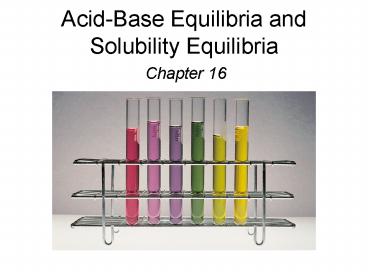AcidBase Equilibria and Solubility Equilibria - PowerPoint PPT Presentation
1 / 33
Title: AcidBase Equilibria and Solubility Equilibria
1
Acid-Base Equilibria andSolubility Equilibria
- Chapter 16
2
The common ion effect is the shift in equilibrium
caused by the addition of a compound having an
ion in common with the dissolved substance.
Consider mixture of CH3COONa (strong electrolyte)
and CH3COOH (weak acid).
16.2
3
Consider mixture of salt NaA and weak acid HA.
Henderson-Hasselbalch equation
pKa -log Ka
16.2
4
What is the pH of a solution containing 0.30 M
HCOOH and 0.52 M HCOOK?
Mixture of weak acid and conjugate base!
0.30
0.00
0.52
-x
x
x
0.30 - x
x
0.52 x
Common ion effect
0.30 x ? 0.30
4.01
0.52 x ? 0.52
HCOOH pKa 3.77
16.2
5
- A buffer solution is a solution of
- A weak acid or a weak base and
- The salt of the weak acid or weak base
- Both must be present!
A buffer solution has the ability to resist
changes in pH upon the addition of small amounts
of either acid or base.
Add strong acid
Add strong base
16.3
6
Which of the following are buffer systems? (a)
KF/HF (b) KBr/HBr, (c) Na2CO3/NaHCO3
(a) HF is a weak acid and F- is its conjugate base
buffer solution
(b) HBr is a strong acid
not a buffer solution
(c) CO32- is a weak base and HCO3- is it
conjugate acid
buffer solution
16.3
7
Calculate the pH of the 0.30 M NH3/0.36 M NH4Cl
buffer system. What is the pH after the addition
of 20.0 mL of 0.050 M NaOH to 80.0 mL of the
buffer solution?
pKa 9.25
9.17
start (moles)
0.029
0.001
0.024
end (moles)
0.028
0.0
0.025
final volume 80.0 mL 20.0 mL 100 mL
9.20
16.3
8
Maintaining the pH of Blood
16.3
9
Titrations
In a titration a solution of accurately known
concentration is added gradually added to another
solution of unknown concentration until the
chemical reaction between the two solutions is
complete.
Equivalence point the point at which the
reaction is complete
Indicator substance that changes color at (or
near) the equivalence point
Slowly add base to unknown acid UNTIL
The indicator changes color (pink)
4.7
10
Strong Acid-Strong Base Titrations
16.4
11
(No Transcript)
12
(No Transcript)
13
Weak Acid-Strong Base Titrations
At equivalence point (pH gt 7)
16.4
14
(No Transcript)
15
(No Transcript)
16
Strong Acid-Weak Base Titrations
At equivalence point (pH lt 7)
16.4
17
Exactly 100 mL of 0.10 M HNO2 are titrated with a
0.10 M NaOH solution. What is the pH at the
equivalence point ?
start (moles)
0.01
0.01
end (moles)
0.0
0.0
0.01
Final volume 200 mL
0.05
0.00
0.00
-x
x
x
0.05 - x
x
x
pOH 5.98
2.2 x 10-11
pH 14 pOH 8.02
0.05 x ? 0.05
x ? 1.05 x 10-6
OH-
18
Acid-Base Indicators
Color of acid (HIn) predominates
Color of conjugate base (In-) predominates
16.5
19
The titration curve of a strong acid with a
strong base.
16.5
20
Which indicator(s) would you use for a titration
of of HNO2 versus KOH ?
Weak acid titrated with strong base.
At equivalence point, will have conjugate base of
weak acid.
At equivalence point, pH gt 7
Use cresol red or phenolphthalein
16.5
21
Solubility Equilibria
Ksp AgCl-
Ksp is the solubility product constant
Ksp Mg2F-2
Ksp Ag2CO32-
Ksp Ca23PO33-2
Dissolution of an ionic solid in aqueous solution
No precipitate
Q lt Ksp
Unsaturated solution
Q Ksp
Saturated solution
Precipitate will form
Q gt Ksp
Supersaturated solution
16.6
22
16.6
23
Molar solubility (mol/L) is the number of moles
of solute dissolved in 1 L of a saturated
solution.
Solubility (g/L) is the number of grams of solute
dissolved in 1 L of a saturated solution.
16.6
24
What is the solubility of silver chloride in g/L ?
Ksp 1.6 x 10-10
0.00
0.00
Ksp AgCl-
Ksp s2
s
s
s
s
s 1.3 x 10-5
Ag 1.3 x 10-5 M
Cl- 1.3 x 10-5 M
1.9 x 10-3 g/L
Solubility of AgCl
16.6
25
16.6
26
If 2.00 mL of 0.200 M NaOH are added to 1.00 L of
0.100 M CaCl2, will a precipitate form?
The ions present in solution are Na, OH-, Ca2,
Cl-.
Only possible precipitate is Ca(OH)2 (solubility
rules).
Is Q gt Ksp for Ca(OH)2?
Ca20 0.100 M
OH-0 4.0 x 10-4 M
0.10 x (4.0 x 10-4)2 1.6 x 10-8
Ksp Ca2OH-2 8.0 x 10-6
Q lt Ksp
No precipitate will form
16.6
27
The Common Ion Effect and Solubility
Br- 0.0010 M
Ksp 7.7 x 10-13
s2 Ksp
Ag s
s 8.8 x 10-7
Br- 0.0010 s ? 0.0010
Ksp 0.0010 x s
s 7.7 x 10-10
16.8
28
pH and Solubility
At pH less than 10.45
Ksp Mg2OH-2 1.2 x 10-11
Lower OH-
Ksp (s)(2s)2 4s3
4s3 1.2 x 10-11
Increase solubility of Mg(OH)2
s 1.4 x 10-4 M
At pH greater than 10.45
OH- 2s 2.8 x 10-4 M
pOH 3.55 pH 10.45
Raise OH-
Decrease solubility of Mg(OH)2
16.9
29
Complex Ion Equilibria and Solubility
A complex ion is an ion containing a central
metal cation bonded to one or more molecules or
ions.
The formation constant or stability constant (Kf)
is the equilibrium constant for the complex ion
formation.
16.10
30
16.10
31
16.11
32
Qualitative Analysis of Cations
16.11
33
lithium
sodium
potassium
copper
16.11































